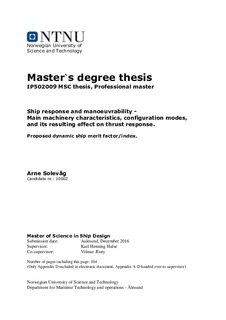| dc.contributor.advisor | Halse, Karl Henning | |
| dc.contributor.advisor | Æsøy, Vilmar | |
| dc.contributor.author | Solevåg, Arne | |
| dc.date.accessioned | 2017-10-24T13:19:53Z | |
| dc.date.available | 2017-10-24T13:19:53Z | |
| dc.date.issued | 2016 | |
| dc.identifier.uri | http://hdl.handle.net/11250/2461883 | |
| dc.description.abstract | This thesis have in general been divided into three parts: Discussion about the traditional approach for station keeping and manoeuvring capability (static approach with dynamic factor), use of more modern tools analysing dynamic capabilities of the vessels (DynCap, and DNVGL DP Level3); Detail study of the main machinery systems as generators and thrusters with their control system to establish and understand the theory and relation between them; Development of a design configuration systematics enabling us to have parameters to perform early stage dynamic calculation analysis and establish dynamic equipment and ship merit factor. | nb_NO |
| dc.description.abstract | There are already today several providers of dynamic simulation tools where you could build virtual models of your vessel and perform analysis at early design. As far as I have found there is no standard way of building the various parts of the models, and these models includes simplifications and assumptions. If we don't properly understand the relations we could end up thrusting the early stage dynamic models and the resulting vessel behaviour too much. | nb_NO |
| dc.description.abstract | This thesis propose two levels of early design approach to ensure that the designer have understanding of applicable load combinations and dynamic relation of combination of main propulsion machinery configurations. The equipment category and dynamic merit factors proposed in Part 2, could form a basis for a future dynamic categorization system that will enable us to make better use of 3rd party dynamic analysing tools at an early design phase ("correct" input). Or at least evaluate their results. | nb_NO |
| dc.description.abstract | I have not found other work that tries to link, generalize and simplify the dynamic relations between main machinery and their control systems at an overall level with the intention to make a simple design tool for selecting equipment based on their dynamic behaviour and dependencies. | nb_NO |
| dc.description.abstract | The future for vessels with dynamic position/manoeuvring systems on board I believe will be to have full scale vessel specific dynamic calculating model Incorporated in their control systems, calculating probable resulting deviating positions in event of failures or changed weather. | nb_NO |
| dc.description.abstract | But I still believe that the industry needs an early stage simple design tool or approach to understand and ensure that the dynamic behaviour is understood and controlled. | nb_NO |
| dc.language.iso | eng | nb_NO |
| dc.rights | Attribution-NonCommercial-NoDerivatives 4.0 Internasjonal | * |
| dc.rights.uri | http://creativecommons.org/licenses/by-nc-nd/4.0/deed.no | * |
| dc.subject | Simulation | nb_NO |
| dc.subject | Vessel | nb_NO |
| dc.subject | Control system | nb_NO |
| dc.subject | Main machinery | nb_NO |
| dc.title | Ship response and manoeuvrability - Main machinery characteristics, configuration modes, and its resulting effect on thrust response. Proposed dynamic ship merit factor / index. | nb_NO |
| dc.type | Master thesis | nb_NO |
| dc.subject.nsi | VDP::Technology: 500::Marine technology: 580::Ship technology: 582 | nb_NO |
| dc.source.pagenumber | 104 | nb_NO |

